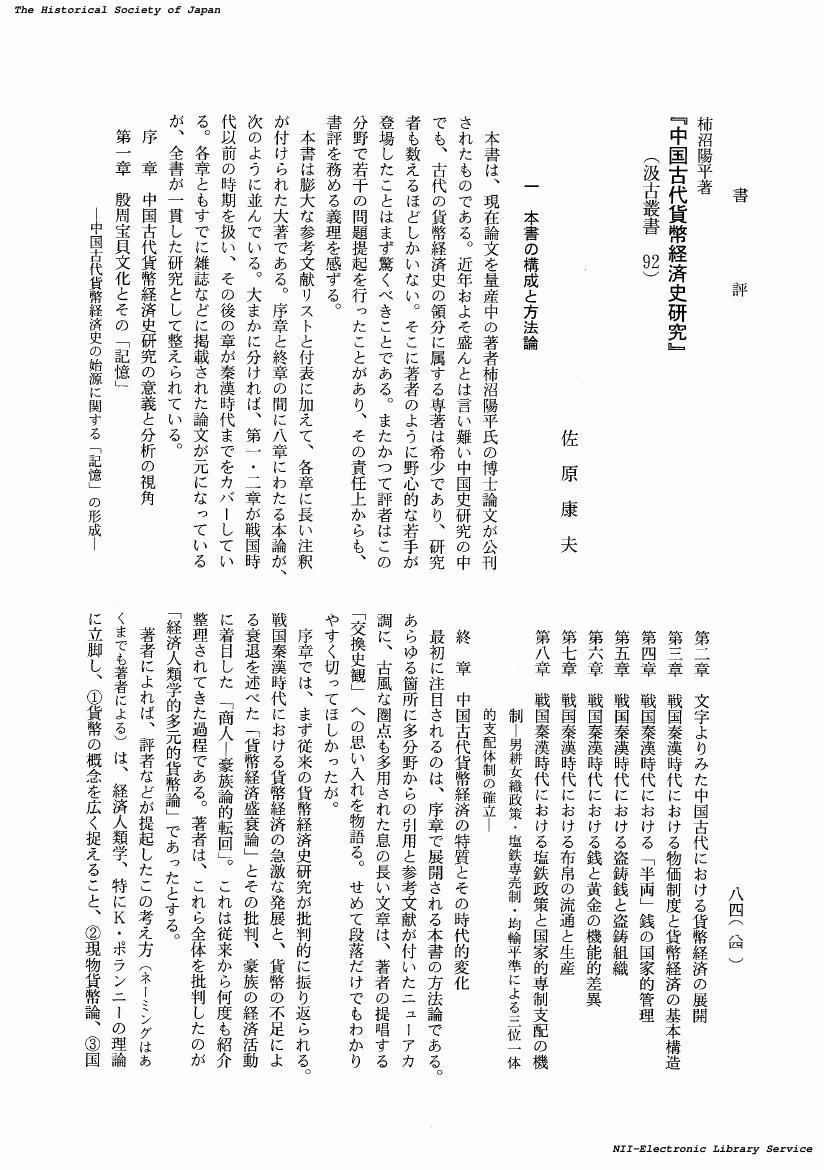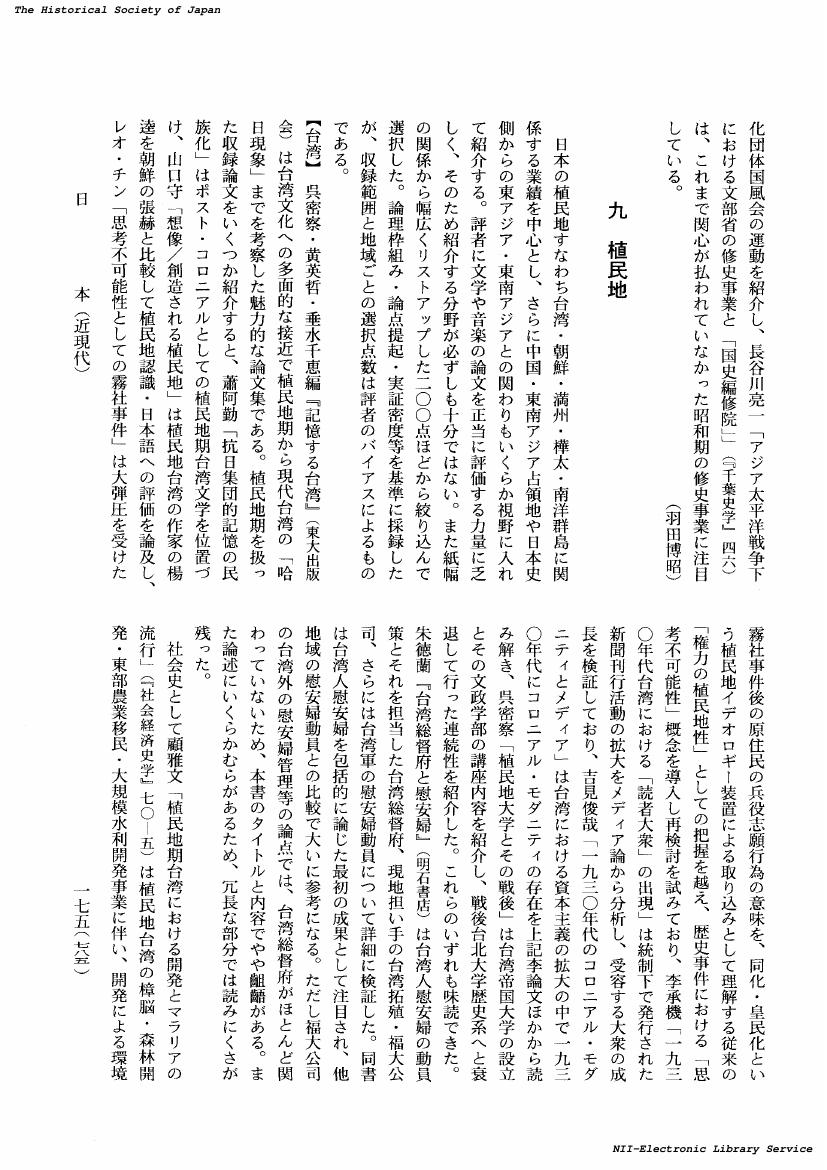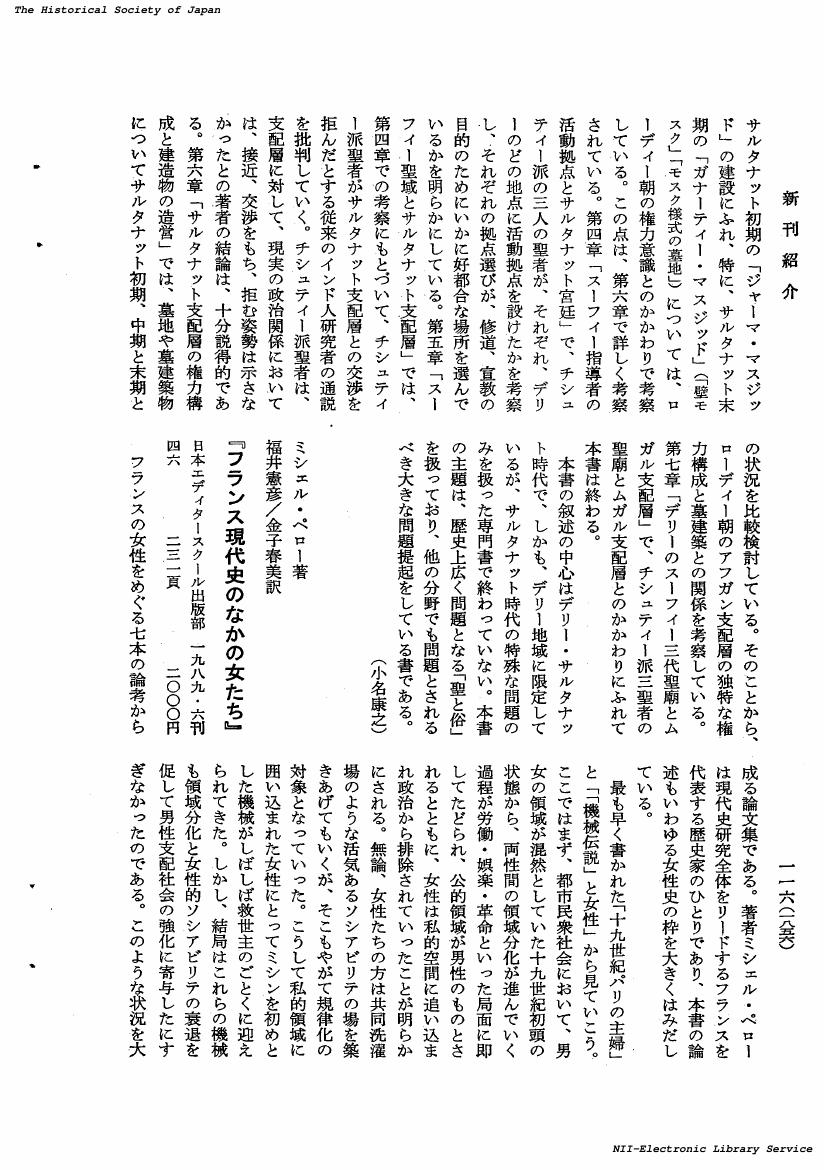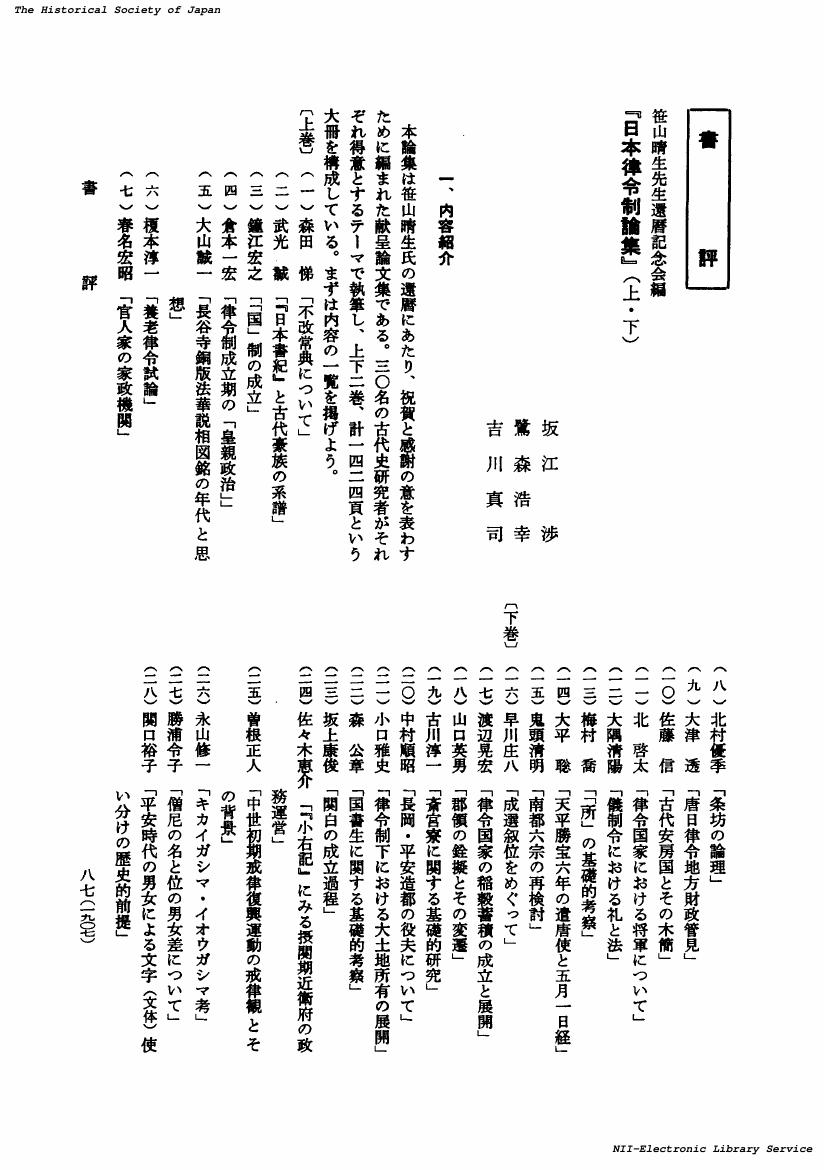- 著者
- 佐原 康夫
- 出版者
- 公益財団法人 史学会
- 雑誌
- 史学雑誌 (ISSN:00182478)
- 巻号頁・発行日
- vol.121, no.1, pp.84-90, 2012-01-20 (Released:2017-12-01)
- 著者
- 佐原 康夫
- 出版者
- 公益財団法人 史学会
- 雑誌
- 史学雑誌 (ISSN:00182478)
- 巻号頁・発行日
- vol.121, no.1, pp.84-90, 2012
- 著者
- 村田 哲也
- 出版者
- 公益財団法人 史学会
- 雑誌
- 史学雑誌 (ISSN:00182478)
- 巻号頁・発行日
- vol.121, no.3, pp.392-401, 2012-03-20 (Released:2017-12-01)
1 0 0 0 OA 石井 孝著『幕末開港期経済史研究』, 有隣堂, 一九八七・六刊, A5, 三九二頁
- 著者
- 横山 伊徳
- 出版者
- 公益財団法人 史学会
- 雑誌
- 史学雑誌 (ISSN:00182478)
- 巻号頁・発行日
- vol.96, no.11, pp.1817-1818, 1987-11-20 (Released:2017-11-29)
- 著者
- 黒嶋 敏
- 出版者
- 公益財団法人 史学会
- 雑誌
- 史学雑誌 (ISSN:00182478)
- 巻号頁・発行日
- vol.122, no.1, pp.101, 2013-01-20 (Released:2017-12-01)
1 0 0 0 OA 平安時代の銭貨流通
- 著者
- 三上 喜孝
- 出版者
- 公益財団法人 史学会
- 雑誌
- 史学雑誌 (ISSN:00182478)
- 巻号頁・発行日
- vol.105, no.9, pp.1-37, 1996-09-20 (Released:2017-11-30)
- 著者
- 渡邉 裕一
- 出版者
- 公益財団法人 史学会
- 雑誌
- 史学雑誌 (ISSN:00182478)
- 巻号頁・発行日
- vol.123, no.1, pp.138, 2014-01-20 (Released:2017-07-31)
1 0 0 0 OA 近現代 九 植民地(日本,2005年の歴史学界-回顧と展望-)
- 著者
- 柴田 善雅
- 出版者
- 公益財団法人 史学会
- 雑誌
- 史学雑誌 (ISSN:00182478)
- 巻号頁・発行日
- vol.115, no.5, pp.785-791, 2006-05-20 (Released:2017-12-01)
1 0 0 0 近現代 九 植民地(日本,2005年の歴史学界-回顧と展望-)
- 著者
- 柴田 善雅
- 出版者
- 公益財団法人 史学会
- 雑誌
- 史学雑誌 (ISSN:00182478)
- 巻号頁・発行日
- vol.115, no.5, pp.785-791, 2006
1 0 0 0 OA ローマ帝国における貨幣と経済 : 三世紀「通貨危機」をめぐる研究動向
- 著者
- 本村 凌二
- 出版者
- 公益財団法人 史学会
- 雑誌
- 史学雑誌 (ISSN:00182478)
- 巻号頁・発行日
- vol.88, no.4, pp.452-480, 1979-04-20 (Released:2017-10-05)
1 0 0 0 OA フランク時代の仮装訴訟とは何か : メロヴィング朝後期の国王法廷の役割に関する一考察
- 著者
- 加納 修
- 出版者
- The Historical Society of Japan
- 雑誌
- 史学雑誌 (ISSN:00182478)
- 巻号頁・発行日
- vol.110, no.3, pp.390-410, 2001-03-20 (Released:2017-11-30)
The fictitious suit (Scheinprozess), that is, court procedure through which a private legal action was confirmed, was held only at the royal tribunal during the period from the late seventh to the early eighth century. In examining this procedure, the author tries to shed light on the role of the royal tribunal in the late Merovingian period. The fictitious suit has been seen as an affirmation of property ownership, or as a means of conveyancing, but it was in reality a confirmation of warranty against eviction (Eviktionshaftung). Therefore it was based on a private legal action following Roman law. Roman private law was practiced until about the middle of the eighth century in the north of the Frankish kingdom called Neustria, but in this region disputes were settled predominantly by unwritten Frankish customs. Although the covenant of warranty against eviction was made on the occasion of conveyance, it had no effect as an objective rule. The use of the fictitious suit by the royal tribunal shows that kingship in the late Merovingian period was trying to cover deficiencies in objective norms. The fictitious suit of the Frankish period could thus be used only at the royal tribunal, and only when and where private legal action was practiced according to Roman law, but disputes were settled by Frankish customs, in Neustria in the late Merovingian period. It is generally acknowledged that the legal life in the Merovingian state is characterized by plurality of law. However, the research has not questioned what role the royal tribunal played in this context. The fictitious suit, which is only one part of the activities of the royal tribunal, shows that Merovingian kingship played an important role as public power, though partially and rudimentarily, whenever and wherever Roman law as the objective norm and Roman administration declined. It also suggests that the royal tribunal was able to cope with juristic situations which varied in different regions.
1 0 0 0 OA 前五世紀アテナイの艦隊乗組員
- 著者
- 岡田 泰介
- 出版者
- 公益財団法人 史学会
- 雑誌
- 史学雑誌 (ISSN:00182478)
- 巻号頁・発行日
- vol.124, no.12, pp.1-36, 2015 (Released:2018-10-05)
I G . I 31 0 3 2、いわゆる A t h e n i a n N a v a l C a t a l o g u e は、古典期アテナイの軍船乗組員の構成を詳細かつ具体的に伝える、現在のところほぼ唯一の史料である。この碑文は、乗組員中に奴隷(t h e r a p o n t e s)が高い比率を占めていることなど、前五世紀アテナイ社会の理解に深くかかわる可能性のある注目すべき情報を含んでいるが、保存状態が悪いうえ、比較すべき類例がほとんどないため、歴史的文脈への位置づけがむずかしい。そこで、現時点でもっとも信頼性が高いと思われる断片配置とテクスト復元にもとづいてこの碑文をあらためて吟味し、そこから知り得ることを確認するとともに、その歴史的意義をあきらかにすることが、本稿の目的である。 まず、年代としては、碑文に内在する手がかりからは、前五世紀末、おそらく前四一二年以前という推定が可能だが、外部史料との照合によっても、それ以上の絞り込み、特定の歴史的 事件との関係づけはむずしいことを確認した。つ ぎに、この碑文から読みとれるアテナイ海軍の状態を一般化できるか否かを、多数の奴隷乗組員の存 在、海兵(e p i b a t a i )の社会的地位、乗組員の徴募方法という三つの指標にそくして考察した。その結果、奴隷と海兵の様態、乗組員の徴募方法のいずれにも、なんらかの特殊な事態を示唆する要素はみられないことがあきらかになった。以上から、この碑文は、例外的な状況ではなく、むしろ、ペロポンネソス戦争期アテナイ海軍の常態を反映した史料と評価することができるとの結論が導かれた 。
- 著者
- 三上 喜孝
- 出版者
- 公益財団法人 史学会
- 雑誌
- 史学雑誌 (ISSN:00182478)
- 巻号頁・発行日
- vol.106, no.9, pp.1712-1713, 1997-09-20 (Released:2017-11-30)
1 0 0 0 田中 浩著『ホッブズ研究序説-近代国家論の生誕-』
- 著者
- 水田 洋
- 出版者
- 公益財団法人 史学会
- 雑誌
- 史学雑誌 (ISSN:00182478)
- 巻号頁・発行日
- vol.92, no.3, pp.377-384, 1983
- 著者
- 中野 隆生
- 出版者
- 公益財団法人 史学会
- 雑誌
- 史学雑誌 (ISSN:00182478)
- 巻号頁・発行日
- vol.98, no.11, pp.1856-1857, 1989-11-20 (Released:2017-11-29)
1 0 0 0 一九〇六年の萍瀏醴蜂起と民衆文化 : 中秋節における謡言を中心に
- 著者
- 藤谷 浩悦
- 出版者
- 公益財団法人 史学会
- 雑誌
- 史学雑誌 (ISSN:00182478)
- 巻号頁・発行日
- vol.113, no.10, pp.1659-1688, 2004
This paper considers the Ping-Liu-Li Uprising of 1906 from the viewpoint of popular culture surrounding the Mid-autumn festival, and focuses on the following three points. First, the Ping-Liu-Li Uprising consisted of many phases, and rumors about the uprising which appeared in the Mid-autumn festival played an important role. The second point is the ideals and world view of the people were contained in the rumors. The third point concerns the connection between those ideals and world view and several leaders of the Tong Meng Hui and the Hong River Society. The Ping-Liu-Li Uprising started with an appeal from the Tong Meng Hui to the secret societies, which resulted in the organization of the Hong River Society. However, the main factor which led to the uprising was popular ideals and world view as reflected in Mid-autumn festival : the idea of the present world coming to an end, the appearance of a savior, and the realization of a peaceful world. It was believed that a savior would come to earth on the night of the Mid-autumn festival and save the people. Ultimately, this meant the return of the fundamental world. It has been said that the Ping-Liu-Li Uprising was raised by leaders of the Tong Meng Hui and the Hong River Society. However, the ideals and world view of the people also played an important role in this uprising. This phenomenon was to be repeated in the Revolution of 1911.
- 著者
- 中野 さやか
- 出版者
- 公益財団法人 史学会
- 雑誌
- 史学雑誌
- 巻号頁・発行日
- vol.113, no.12, 2004
1 0 0 0 OA 琉球王国と中世日本 : その関係の変遷
- 著者
- 黒嶋 敏
- 出版者
- The Historical Society of Japan
- 雑誌
- 史学雑誌 (ISSN:00182478)
- 巻号頁・発行日
- vol.109, no.11, pp.1992-2014, 2000-11-20 (Released:2017-11-30)
The research done to date on the relations between Japan and the Ryukyu Islands has tended focus its discussion on the Shimazu family of the Satsuma region in Kyushu. The Shimazu family was not only granted various rights over the Ryukyus, but also carried out a direct invasion of its territory. It is true that many of the historical sources related to the subject come from the Shimazu family, and it cannot be denied that the two regions were closely related geographically. However, it is the opinion of the author of the present paper that the focus of the research to date has placed to much emphasis on the history of the Shimazu family rather than the history of international relations between two countries. He sets out to reexamine the research and offer a broader point of view, while criticizing the conventional interpretation of the Shimazu family documents. As the result of this examination, the author divides the relations between medieval Japan and the Ryukyu Kingdom into four different periods. The first period, spanning the first half of the fifteenth century, involved mainly the Muromachi Bakufu on the Japan side, which dispatched emissaries to the Ryukyus on a yearly basis. During the second period, from 1470 to 1520, the Hosokawa family issued sealed orders permitting such parties as pirates on the Inland Sea and the Shimazu family to conduct maritime trade with the Ryukyus. The focus of the third period, 1520 to 1560, shifted to the Ouchi family, as internal division spread among the Shimazu resulting in a loss of their political influence in Ryukyu affairs. The final period, from 1560 on, centered around the Shimazu family, now unified as a powerful sengoku daimyo and assuming a position to demand exclusive rights to deal with the Ryukyus. It was also a time that the Ryukyu Kingdom attempted to free itself from international relations in which it was subordinated to Japan. According to this periodization scheme, it is clear that the Shimazu family played the role of a mere intermediary during most of the medieval period. Throughout the period, the Ryukyus were placed by Japan within subordinate relationships to political forces centered on the Muromachi shogunate.
1 0 0 0 梁簡文帝立太子前夜 : 南朝皇太子の歴史的位置に関する一考察
- 著者
- 岡部 毅史
- 出版者
- 公益財団法人 史学会
- 雑誌
- 史学雑誌 (ISSN:00182478)
- 巻号頁・発行日
- vol.118, no.1, pp.1-33, 2009
In the fourth month of Zhongdatong 中大通 3(531), about thirty years after the Qi 斉 dynasty of the Southern Dynasties had been replaced by the Liang 梁 and at a time when the realm was at peace, the emperor Xiao Yan 蕭衍 (Wudi 武帝) was confronted with the question of choosing a successor. His eldest son Xiao Tong 薫統 (Zhaoming Taizi 昭明太子), the crown prince, had died suddenly at the early age of thirty one. At the time, the major contender for the position of successor to the throne was considered to be Xiao Tong's eldest son Xiao Huan 蕭歓. But after the position of crown prince had been left vacant for about three months, it was to much surprise Wudi's third son Xiao Gang 蕭綱 -Xiao Tong's uterine brother and the subsequent emperor Jian-wen-di 簡文帝 who was designated crown prince by Wudi. This deviated from the principles of the contemporary inheritance system, and it has generally been considered that this investiture of Xiao Gang as crown prince, which caused popular disquiet, had its origin in antagonism between Wudi and Xiao Tong and became one of the causes of the political upheavals towards the end of the Liang. But it can hardly be said that there has until now been adequate discussion of Wudi's intentions in reaching what was an extremely important political decision, namely, the nomination of crown prince. In this article, I undertake an analysis of the background to this incident and examine the reasons for Xiao Gang's investiture as crown prince. In doing so, I ascertain the nature of the institution of crown prince from the Qin 秦 and Han 漢 through to the Northern and Southern Dynasties and touch on the characteristics of the institution of crown prince during the Southern Dynasties. I do this because it is to be supposed that, through an examination of the background to and characteristics of this political question, some light may be shed on the distinctive nature of the crown prince during the Six Dynasties and also on the historical position in which crown princes found themselves in ancient China.
- 著者
- 坂江 渉 鷺森 浩幸 吉川 真司
- 出版者
- 公益財団法人 史学会
- 雑誌
- 史学雑誌 (ISSN:00182478)
- 巻号頁・発行日
- vol.105, no.11, pp.87-95, 1996-11-20 (Released:2017-11-30)










